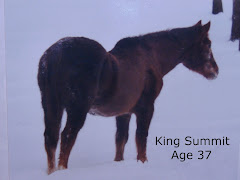

In the past week, I have done some things that were a bit stupid, and in one case, dangerous. The water hose that runs to the large 12x12 stalls is very long. I believe around 100 feet. For the past year,whenever it gets a leak, I wrap the spot with duct tape. As expected, this quick fix only lasts a short time. The holes had gotten so large and numerous that it was effecting the water pressure in the hose. I have no patience when it comes to waiting while a water buckets fill with water. Often I will do some small task and ineveitably I forget about the hose, and the bucket overflows. Standing next to the bucket for an length of time seems like a waste of my time! There was a box of hose fittings in the garage, so I decided to "properly" fix the hose. I suppose I could have purchased a new hose, but it seemed like a waste of 90 feet of hose. I got a razor knife, hose coupling and pot of boiling water. The water is to pour over the cut ends of the hose so they easily slide onto the connector. Job done, I dragged the end on the hose to the water bucket, turned on the water, and promtly discovered that I had missed a few holes. So much for being so cost efficient. Yesterdays lack in judgement involved bees of which I am allergic. Fancy was in her stall eating her dinner. I decided to give her a good grooming. On the opposite side of her stall door is a window. As the brush and curry comb got dirty, I was banging them against the window sill. Suddenly, Fancy shied away from her grain bucket, and started jumping around her stall. At the same time, something was buzzing around my head. Since I am allergic to bees, I also started to panic. Here I was in a stall with Fancy jumping around, bees buzzing around my head, and I am opposite from the stall door. I felt bad for Fancy, but knew that if I got stung, I'd have to go to the local Emergency Room. Finally, I got out of the stall, ran out of the barn, and yelled for Tom and Mark. As they were running to the barn, I was yelling "bees, get Fancy out of her stall". Tom was yelling to me "Get out of there before you get stung, wheres the Wasp killer?", to which I replied "If I get out of here, how can I show you where the wasp killer is located?". Mark got Fancy out of her stall, Tom found the wasp killer, I didn't get stung, and we now keep a can of spray in the barn, along with one of my Epipens in the barn first aid kit!










